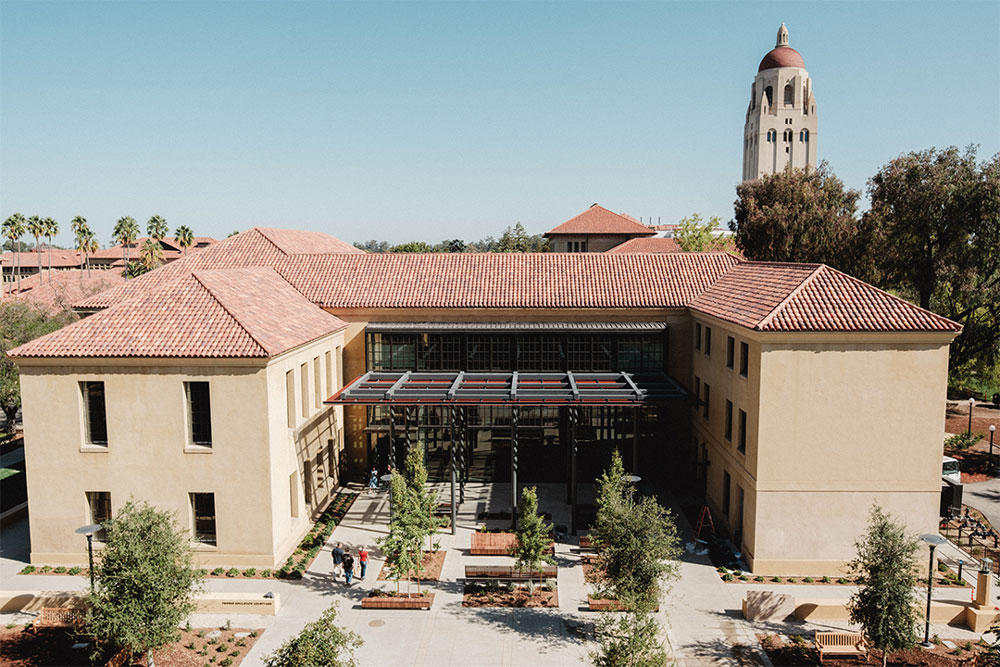Pipe dreams.
Out of sight, out of mind—that’s the typical fate of our wastewater. But there’s treasure in that trash, and Stanford researchers are tapping into it for nutrients and minerals, drinking water, energy, and information. Among those scientists is assistant professor of chemical engineering William Tarpeh, ’12, who was just named a 2025 MacArthur Fellow for his development of scalable methods for recovering valuable chemical resources from wastewater. He’s focused on extracting ammonia—a pollutant—so it can be reused in fertilizer.
Happy 100th, GSB!
The Stanford Graduate School of Business opened in October 1925 with 16 students, three faculty members, and a goal: to give Stanford undergraduates an option to pursue graduate education in business on the Pacific Coast. Since then, the GSB has become a catalyst for innovation around the world and counts among its alumni the forces behind Nike, Sun Microsystems, Trader Joe’s, and more. Stanford magazine showcased a few of the school’s signature moments and milestones over the past century.
The GSB is celebrating its anniversary with events and stories, including the rise and fall of buzzwords (Who knew “best practices” only became a best practice in the ’80s?), things that wouldn’t exist if not for the GSB alums behind them (from the first hospital “crash cart” to Jell-O Jigglers), groundbreaking research by GSB faculty, and the origins of the famously popular course Interpersonal Dynamics (aka Touchy Feely).
Open for education.
 Photo: Ryan Zhang
Photo: Ryan Zhang
Tractors and cement mixers are so last season. This autumn, after three years of construction, the Stanford Graduate School of Education opened the doors on its new, light-filled hub, which GSE dean Dan Schwartz said was designed "to support the three C’s—collaboration, connection, and convening."
Don’t blink: a quicker treatment for cancer.
Radiation therapy is used to treat roughly two-thirds of all cancer patients. The blasts of high-energy particles get rid of cancer cells, but healthy cells become collateral damage, especially because patients—who need to do things like breathe—can’t remain perfectly still. But what if radiation could be delivered so quickly that patients didn’t have time to move? That was the question behind Billy Loo’s new pluridirectional high-energy agile scanning electron radiotherapy (PHASER)—a technology that transmits highly targeted doses of radiation in a fraction of a second. To deliver the ultra-fast beams, Loo, a professor of radiation oncology, and his team invented a new class of highly efficient linear accelerators that, alongside new power methods and electronic controls, cut the radiation delivery time 500-fold. PHASER will look like a CT scanner, and it could be available to patients within four years. “This will have a huge impact,” said Loo. “We’ll see better treatment outcomes, higher rates of cure, and cures with less side effects.”
Back in the game.
A year ago, just ahead of a planned move away from Palo Alto, Andrew Luck met with Stanford president Jonathan Levin. Luck, ’12, MA ’23, wanted to make sure Levin, ’94, was aware of the existential threat to college football. Levin was, and he had a question that caught Luck off guard: Would Luck become general manager of Stanford Football? Since taking on the role, Luck has been calling alumni, joining in practice drills, making staffing decisions, and grappling with the changing landscape of college athletics. It’s all in pursuit of rebuilding the team that launched his career. Football “has been a part of the fabric of this university since four months after the doors opened,” Luck told Stanford magazine. “Part of what I view as my job is reminding people, starting with our most proximal community, that we’ve got to keep playing football at that top level.”
But wait, there’s more. . .
Tarpeh’s not the only genius with ties to the Farm: Hahrie Han, MA ’02, PhD ’05, a political scientist at Johns Hopkins, was also named a MacArthur Fellow. Her work focuses on political organizing and collective action.
Michael McFaul, a professor of political science and the director of the Freeman Spogli Institute for International Studies, offers five lessons on how and why the world’s great powers compete.
At the recent Stanford Open Minds event in New York, professor of computer science Fei-Fei Li, professor of economics Susan Athey, PhD ’95, and director of the Stanford Institute for Economic Policy Research Neale Mahoney, MA ’11, PhD ’11, brought their perspectives to a live recording of the Future of Everything podcast on how artificial intelligence is reshaping our economy.
Philanthropist and former Stanford trustee Bradford Freeman, ’64, has donated $50 million to Stanford Football—a gift that President Levin called game-changing for athletics across the university.
Researchers have cracked the elusive pigment code of a vivid tint in Jackson Pollock’s Number 1A, 1948—a manganese blue whose electronic structure filters out light in the green and violet regions for a particularly pure and luminous hue.
The nation’s first student-run space law publication has, well, launched. The inaugural issue of Stanford Space Law and Policy Perspectives includes articles on how Silicon Valley’s satellites could be targeted and how to deal with space trash.
Stanford’s newest barista (better known as university president Jonathan Levin) stopped by the student-run On Call Café recently, apron and all. Photographic evidence here.
Note: The Loop sometimes links to articles outside of Stanford that may require a subscription to view.



